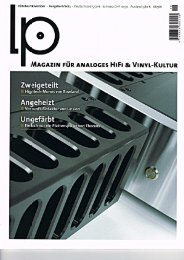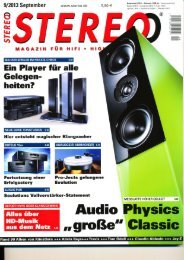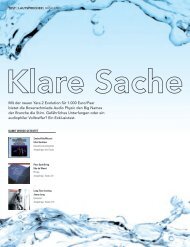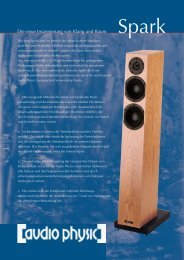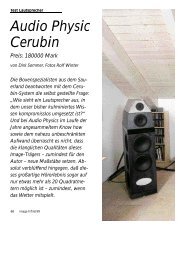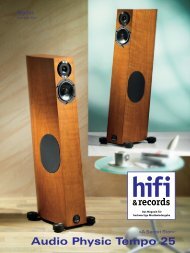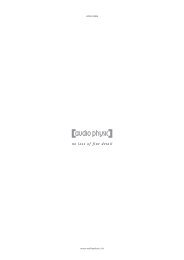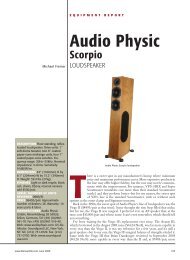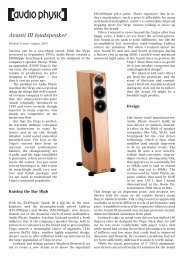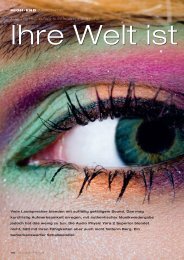Audio Physic Portrait :: Hörerlebnis
Audio Physic Portrait :: Hörerlebnis
Audio Physic Portrait :: Hörerlebnis
You also want an ePaper? Increase the reach of your titles
YUMPU automatically turns print PDFs into web optimized ePapers that Google loves.
<strong>Audio</strong> <strong>Physic</strong>: <strong>Portrait</strong><br />
DAS MAGAZIN FÜR HIGH FIDELITY<br />
www.hoererlebnis.de<br />
<strong>Hörerlebnis</strong>
Firmenportrait: <strong>Audio</strong> <strong>Physic</strong><br />
Kaum ein deutscher Lautsprecherherstel-<br />
ler hat weltweit einen so guten Ruf wie das<br />
Team um Dieter Kratochwil aus Brilon. Im traditionsreichen<br />
Sauerland überrascht <strong>Audio</strong><br />
<strong>Physic</strong> die einschlägige Szene seit über 27<br />
Jahren immer wieder mit Innovationen. Auch<br />
von Regina Wegers<br />
Die Drei von der Boxenstelle: (v.l) Dipl. Ing. Manfred<br />
Diestertich (Entwickler), Dieter Kratochwil (Geschäftsführer),<br />
Stefan Dreischärf (Vertriebsleiter Deutschland).<br />
für die Zukunft ist man hier gut gerüstet.<br />
Mitten im Sauerland liegt das idyllische<br />
Brilon, dessen Stadtbild malerische, schiefergedeckte<br />
Häuser prägen. Die alte Hansestadt<br />
versteht sich als Zentrum für Wanderer. Doch<br />
noch besser würde ihr zu Gesicht stehen, verstünde<br />
sie sich als ein Zentrum für audiophiles<br />
Hören. Denn seit über einem Vierteljahrhundert<br />
fertigt hier die weltweit bekannte<br />
Lautsprechermanufaktur <strong>Audio</strong> <strong>Physic</strong>. "Zum<br />
Verlieben vielfältig" lautet ein Werbeslogan<br />
Wir bauen keine Kisten,<br />
nur um darin Luft einzusperren<br />
<strong>Hörerlebnis</strong>
<strong>Audio</strong> <strong>Physic</strong><br />
der Stadt, der damit auf die zahlreichen lokalen<br />
Facetten hinweist. Bestimmt genauso vielfältig<br />
ist das Produktportfolio des High-End-<br />
Herstellers.<br />
Der Grundstein für das Unternehmen<br />
wurde 1985 von Willi Hegener, der heute<br />
noch zu den Inhabern gehört, und Joachim<br />
Gerhard gelegt. Gegenwärtig leitet Dieter Kratochwil<br />
erfolgreich die kaufmännischen Geschicke<br />
und kümmert sich auch um das<br />
Exportgeschäft. Der gebürtige Bayer mit Lebensmittelpunkt<br />
in Westfalen stieß 2003 zu<br />
<strong>Audio</strong> <strong>Physic</strong> und positionierte die mittelständische<br />
Firma in einem heiß umkämpften<br />
Markt völlig neu. In der Hifi-Szene war er damals<br />
ein Unbekannter, jedoch nicht in der Musikszene.<br />
Schon während meiner Studienzeit<br />
in Münster hatte ich viele meiner Schallplatten<br />
im angesagten In-Laden "Cha-Cha" gekauft,<br />
der - nun dürfen Sie dreimal raten - wem gehörte?<br />
Natürlich Dieter Kratochwil. Es ist doch<br />
immer wieder erstaunlich, auf welche Weise<br />
einen die eigene Vergangenheit einholt.<br />
Joachim Gerhard hatte seinerzeit als Entwickler<br />
den <strong>Audio</strong>-<strong>Physic</strong>-Klang kreiert, mit<br />
dem er weltweit seinen Siegeszug antrat. Dieser<br />
zeichnete sich durch einen sehr sauberen,<br />
entschlackten Klang aus. 1993 kam<br />
Bernd Theis als neuer Entwickler hinzu. Er<br />
wechselte jedoch nach wenigen Jahren zur<br />
schreibenden Fachzunft. Seit 1999 bestimmt<br />
Manfred Diestertich die klangliche Ausrichtung:<br />
eine Wahl, die bis heute Bestand hat<br />
und deren Weg von vielen Innovationen im<br />
Manfred Diestertich zeigt exemplarisch wie die Falttechnik<br />
beim Zusammenbau eines Lautsprechers funktioniert<br />
(oben und Mitte).<br />
Der Entwicklungsleiter prüft jedesmal die Qualität der<br />
chinesischen Rohweichen.<br />
Was gut klingt, muss sich auch gut messen lassen:<br />
Manfred Diestertich überlässt nichts dem Zufall (rechts).<br />
<strong>Hörerlebnis</strong>
Lautsprecherbau gekennzeichnet ist. Zuvor<br />
hatte Manfred Diestertich als Entwicklungschef<br />
für I.Q HiFi Technik bereits einige Hifi-<br />
Klassiker entworfen und Pioneer- sowie Yamaha-CD<br />
Recorder klanglich auf Vordermann<br />
gebracht. Überdies ist er der geistige Vater<br />
der Stringtechnologie, die in den SSC-Produkten<br />
Gerätefüssen und Basen eingesetzt<br />
wird. Zum Triumvirat gehört noch Stefan Dreischärf<br />
(Ex-Accuphase), dessen Hauptbetätigungsfeld<br />
der nationale Verkauf ist. Damit<br />
verfügt <strong>Audio</strong> <strong>Physic</strong> über ein gerütteltes Maß<br />
an Kompetenz in allen wesentlichen Schlüsseldisziplinen<br />
und somit über die besten Voraussetzungen<br />
für die Zukunft. Dieter Kratochwil<br />
gibt sich dennoch bescheiden: "Wir<br />
gehören nicht zu den ganz Großen. Aber wir<br />
möchten gerne der Größte unter den Kleinen<br />
werden."Heute beschäftigt <strong>Audio</strong> <strong>Physic</strong> rund<br />
20 Mitarbeiter. Seit der Gründung dabei ist die<br />
gute Seele des Hauses: Buchhalterin Helga<br />
Rehm.<br />
<strong>Audio</strong> <strong>Physic</strong><br />
Ein wesentlicher Einschnitt im Zuge der<br />
neuen Ausrichtung war die Sortimentsbereinigung<br />
durch die neuen Masterminds. "Wir beschränken<br />
uns auf das, was wir am besten<br />
können: Boxen bauen", sagt der Hobbyskiläufer<br />
Manfred Diestertich. Daraufhin wurden<br />
alle Fremdvertriebsaktivitäten nach dem Ausscheiden<br />
des Mitbegründers Joachim Gerhard<br />
eingestellt. Immerhin kümmerte sich <strong>Audio</strong><br />
<strong>Physic</strong> viele Jahre in Deutschland um<br />
Immedia- und Forsell-Laufwerke, die Adyton-<br />
Elektronik, Wire-World-Kabel und Lyra-Tonabnehmer.<br />
Brilon verströmt einen ganz eigenen<br />
Charme. Dieser Ort hat etwas Friedliches, Angenehmes.<br />
Und genauso gestaltet sich unser<br />
<strong>Hörerlebnis</strong>-Besuch. Jeder Mitarbeiter grüßt<br />
freundlich und es wird viel gelacht. Das ist das<br />
beste Zeichen für ein gutes Betriebsklima.<br />
Wenn das stimmt, sind Motivation und Leistungsergebnisse<br />
hoch.<br />
Ein Problem, mit dem sich Manfred Dies-
<strong>Audio</strong> <strong>Physic</strong><br />
tertich ständig konfrontiert sieht, sind die immer<br />
schneller wechselnden Hype-Zyklen bei<br />
den Kundenwünschen. War bis vor zwei<br />
Jahren die Nachfrage nach Ahorn- und Alu-<br />
Oberflächen kaum zu bedienen, sank sie<br />
plötzlich auf null. So befindet er sich in einem<br />
steten gedanklichen Prozess, was er bezüglich<br />
Chassis und Gehäuseoptik machen soll.<br />
Gleichzeitig ist er kein Freund von inflationärer<br />
Modellpolitik. Schließlich zahlten <strong>Audio</strong><br />
<strong>Physic</strong> Kunden für einen wertbeständigen<br />
Lautsprecher. In einem wesentlichen Punkt<br />
unterscheidet sich <strong>Audio</strong> <strong>Physic</strong> von vielen<br />
Konkurrenten: Die Chassis sind Eigenentwicklungen,<br />
die bei Wavecor exklusiv für die<br />
Briloner gefertigt werden. Es wird nicht wie so<br />
oft beim Mitbewerber Stangenware zugekauft<br />
und lediglich in ein Gehäuse geschraubt.<br />
Wavecor wurde von zwei ehemaligen DST -<br />
(Danish Sound Technology, zu der Vifa, Scan<br />
Speak und Peerless gehörten) Entwicklungsingenieuren<br />
gegründet. Deren Idee war es,<br />
eine eigene, kleine Produktion in China aufzubauen.<br />
Das erste Projekt mit <strong>Audio</strong> <strong>Physic</strong><br />
war der MT mit Doppelkorb, das nächste die<br />
zweite Generation des Konushochtöners.<br />
Die Produktpalette von <strong>Audio</strong> <strong>Physic</strong> umfasst<br />
zurzeit 18 verschiedene Modelle, an deren<br />
Spitze die Cardeas steht. Aktive Subwoofer<br />
gibt es auch, doch sind diese weniger im<br />
klassischen Hifibereich gefragt, mehr im<br />
Die Modelle der Referenz-Serie (oben) werden im Haupthaus<br />
gefertigt, die Klassik-Serie ist ausgelagert.<br />
In der Entwicklungsabteilung stehen verschiedene Versuchsaufbauten.<br />
Hier wurde mit Alternativmaterialien<br />
wie Keramikschaum experimentiert. (nächste Seite<br />
rechts unten). Gute Ergebnisse fließen in die Serie ein.<br />
Stringtechnologie: Sie findet sich nicht nur wie hier im<br />
CD-Spielerlaufwerk, sondern auch in verschiedenen<br />
Boxen wieder.<br />
Im Hörraum unterziehen sich alle <strong>Audio</strong> <strong>Physic</strong>-Lautsprecher<br />
einem intensiven Hörtest. Die Abhörelektronik<br />
stammt übrigens von Burmester und Trigon (rechts).<br />
<strong>Hörerlebnis</strong>
Heimkinobereich. Die Gehäuseteile der neuen<br />
Classic Serie werden nicht mehr in Asien,<br />
sondern in Europa gefertigt, erzählt Manfred<br />
Diestertich. Der Grund mutet im ersten Moment<br />
irritierend an: Das Land der aufgehenden<br />
Sonne mit der weltweit höchsten Bevölkerungszahl<br />
hat Personalprobleme. Dabei<br />
hatte <strong>Audio</strong> <strong>Physic</strong> die Produktion der Gehäuse<br />
nur deshalb nach China verlagert, weil<br />
hierzulande niemand die gewünschte Qualität<br />
liefern konnte.<br />
In Brilon fertigt <strong>Audio</strong> <strong>Physic</strong> selbst an<br />
zwei Standorten. Die Modelle der High-Endund<br />
Referenz-Serien werden im Stammhaus<br />
im Almerfelderweg 38 gebaut. Für die Klassik-<br />
Serie wurde wenige Minuten entfernt eigens<br />
eine Halle mit Hochregallager angemietet. Jeder<br />
Mitarbeiter baut hier wie drüben eine Box<br />
von Anfang bis Ende. Die Gehäuseteile der<br />
Klassik-Serie stammen aus den Niederlanden<br />
und sind so konzipiert, dass ihr Grundkorpus<br />
mittels einer Falttechnik montiert werden kann
<strong>Audio</strong> <strong>Physic</strong><br />
Nach dem Baukastenprinzip wird ansch-<br />
ließend die vom Kunden gewünschte Oberfläche<br />
- auch farbig lackiertes Glas ist möglich -<br />
aufgebracht. Einfacher und präziser geht's<br />
nimmer. Die Weichen stammten übrigens aus<br />
China, sagt Manfred Diestertich, während er<br />
einen großen Karton öffnet und eine einzelne<br />
herausholt. Ob der exzellenten Verarbeitung<br />
glänzen seine Augen. Und um die Richtigkeit<br />
seiner Aussage zu bekräftigen, fügt er hinzu,<br />
dass er noch keinen einzigen Ausfall gehabt<br />
habe. In Brilon werden dann noch ausgesuchte<br />
Kondensatoren, Widerstände und Kabel<br />
nachbestückt. Von Zeit zu Zeit steht der Diplom-Ingenieur<br />
selbst an der Fertigungsstraße.<br />
Er lässt es sich nicht nehmen, die Lautsprecher<br />
auch eigenhändig zusammenzubauen.<br />
Für einen Entwickler sei es wichtig, jeden einzelnen<br />
und nötigen Handgriff zu kennen.<br />
An den verschiedenen Standorten stehen<br />
mobile Messstationen für die Endkontrolle.<br />
Die DAAS-Systeme stammen von Jürgen<br />
Ultee, der ebenfalls als Entwickler für die<br />
Elektronik von van den Hul verantwortlich<br />
zeichnet. Wir lassen den Blick durch die Fertigungshalle<br />
streifen. Er bleibt an einem<br />
Schrank voll mit Bauteilen hängen. Manfred<br />
Diestertich kennt jedes davon aus dem Effeff<br />
und weiß zudem wie jedes klingt.<br />
Zurück im Hörraum sprechen wir über Zukunftspläne.<br />
In geschäftlicher Hinsicht ist Au-<br />
Kontakt:<br />
<strong>Audio</strong> <strong>Physic</strong> GmbH<br />
Almerfeldweg 38<br />
59929 Brilon<br />
Tel.: +49(0)2961-961 70<br />
Fax: +49(0)02961-516 40<br />
E-Mail: info@audiophysic.de<br />
Internet: www.audiophysic.de<br />
dio <strong>Physic</strong> bemüht, mindestens die Marktanteile<br />
zu halten und überdies neue Länder hinzuzugewinnen.<br />
"Beispielsweise sind wir noch<br />
nicht in Japan präsent", so Dieter Kratochwil.<br />
Das bedeutet für das Team weiterhin alle<br />
wichtigen Messen dieser Welt zu besuchen.<br />
Technologisch, prognostiziert Manfred Diestertich,<br />
wird sich in den nächsten Jahren sehr<br />
viel tun. Bei den Chassis sei das Ende der<br />
Fahnenstange noch nicht erreicht. Hier passiere<br />
noch sehr viel. Was sich getan hat, zeige<br />
sich darin, dass man inzwischen nicht<br />
mehr wie früher in der Situation sei, sich von<br />
einer Hifianlage diktieren zu lassen, ob sie<br />
laut oder leise zu spielen habe, wenn sie klingen<br />
solle. Die Hauptaufgabe wird es sein, mechanische<br />
Verluste zu minimieren, Bremsen<br />
und dämpfende Elemente aus den Konstruktionen<br />
herauszunehmen, ohne sich unerwünschten<br />
Eigenklang durch Resonanzen<br />
einzuhandeln. In diese Richtung bewegen<br />
sich seine Überlegungen bei der Chassisentwicklung.<br />
Bei der Konstruktion neuer Gehäuse<br />
geht Manfred Diestertich noch einen<br />
Schritt weiter: "Es kann durchaus sein, dass<br />
es die strikte Abgrenzung zwischen Innenvolumen<br />
und Gehäusewänden in Zukunft nicht<br />
mehr gibt." Versuche mit Schaumkonstruktionen<br />
oder alternativen Materialen hat er schon<br />
gemacht. Die Prototypen stehen in der Entwicklungsabteilung.<br />
Auch die SSC-Technik wird weiterentwickelt.<br />
In der neuen Generation der SSC-<br />
Elemente gibt es drei konzentrische Ringe,<br />
die über die bekannte Gewebekonstruktion<br />
miteinander verbunden sind und unterschiedliche<br />
Konfigurationen für spezielle Anwendungen<br />
ermöglichen. Unter Lautsprecher oder<br />
Komponenten gestellt, sei der klangliche Einfluss<br />
nicht zu überhören. Ebenso profitiere<br />
<strong>Hörerlebnis</strong>
das Bild von Fernsehern und PC-Monitoren<br />
davon. Dieter Kratochwil gibt sich optimistisch.<br />
Er sitzt hinter seinem Schreibtisch und<br />
schaut in seine Unterlagen. Als der studierte<br />
Betriebswirt seinen Kopf hebt, lächelt er<br />
freundlich. Dabei strahlt er Zufriedenheit aus,<br />
denn pro Jahr finden nach seinen Infos doch<br />
einige tausend Paare den Weg zum Kunden.<br />
Er ist sich sicher, den klassischen High End-<br />
Lautsprecher werde es weiterhin geben, allerdings<br />
mit dem Unterschied, dass <strong>Audio</strong> <strong>Physic</strong><br />
künftig nicht nur Kisten baue, in die man<br />
Chassis einschraube und Luft einsperre. Eine<br />
solche Aussage macht neugierig. RW<br />
<strong>Audio</strong> <strong>Physic</strong><br />
<strong>Hörerlebnis</strong>
Company <strong>Portrait</strong>: <strong>Audio</strong> <strong>Physic</strong><br />
DAS MAGAZIN FÜR HIGH FIDELITY<br />
www.hoererlebnis.de<br />
The H ö r e r l e b n i s magazine
Company <strong>Portrait</strong>: <strong>Audio</strong> <strong>Physic</strong><br />
Barely any other German loudspeaker<br />
manufacturer has such an excellent global reputation<br />
as Dieter Kratochwil’s team in the German<br />
town of Brilon. The company <strong>Audio</strong> <strong>Physic</strong>, which<br />
is based in the highly traditional Sauerland region<br />
of Germany, has been constantly astonishing the<br />
loudspeaker scene with its innovations for over<br />
von Regina Wegers<br />
“We don‘t build boxes<br />
just to trap air in them.“<br />
The three faces of the loudspeaker manufacturer: (from left)<br />
Dipl.-Ing. Manfred Diestertich (Chief Designer), Dieter Kratochwil<br />
(Managing Director) and Stefan Dreischärf (Head of Sales Germany)<br />
27 years and is also excellently equipped to face the<br />
challenges of the future.<br />
The idyllic town of Brilon, which was a<br />
member of the historic Hanseatic League, is located<br />
in the heart of the Sauerland region and is characterised<br />
by its picturesque slate-roofed houses. Although<br />
Brilon is well-known as a popular location among<br />
hikers, its main selling-point should be its reputation<br />
as a hotspot for audiophile listening, because the<br />
popular international loudspeaker manufacturer<br />
<strong>Audio</strong> <strong>Physic</strong> has been producing its speakers here<br />
for over a quarter of a century. One of the advertising<br />
slogans used by the town is "Breathtakingly Diverse",<br />
<strong>Hörerlebnis</strong>
<strong>Audio</strong> <strong>Physic</strong><br />
which refers to its numerous local facets and is<br />
also a perfect description of the product<br />
portfolio of its high-end manufacturer.<br />
<strong>Audio</strong> <strong>Physic</strong> was established by Willi<br />
Hegener, who is still one of its proprietors, and<br />
Joachim Gerhard in 1985. The company’s<br />
current Managing Director is Dieter Kratochwil,<br />
who successfully controls its commercial<br />
activities and is also responsible for its export<br />
business. Kratochwil, who was born in the<br />
German Land of Bavaria, joined <strong>Audio</strong> <strong>Physic</strong><br />
in 2003 and helped the medium-sized<br />
company to establish a completely new<br />
position in the hard-fought market. Although he<br />
was unknown in the hi-fi world at the time, he<br />
had certainly made a name for himself on the<br />
music scene. In fact, during my time as a<br />
student in the German city of Münster, I<br />
purchased a large number of vinyl records<br />
from a hip and popular shop called “Cha-Cha”,<br />
which was owned by – you guessed it – Dieter<br />
Kratochwil! It’s certainly amazing how your<br />
past can sometimes catch up with you!<br />
The <strong>Audio</strong> <strong>Physic</strong> sound was created by<br />
Joachim Gerhard during his time as a designer<br />
at the company and helped him to achieve<br />
triumphant success on a global level. It<br />
particularly stood out due to its extreme clarity<br />
and no-frills sonic approach. Bernd Theis<br />
joined the company as a new developer in<br />
1993, but changed paths to join the writers of<br />
the industry after just a few years. Manfred<br />
Diestertich has been responsible for <strong>Audio</strong><br />
<strong>Physic</strong>’s sound orientation since 1999 and has<br />
proven to be the ideal man for the job, helping<br />
Manfred Diestertich demonstrates by way of example<br />
how folding techniques are used in the construction<br />
of a loudspeaker (in the top and middle photographs).<br />
The Chief Designer checks the quality of every single<br />
one of the raw crossover components from China<br />
(left).<br />
A loudspeaker that sounds good also needs to provide<br />
good measurements: Manfred Diestertich leaves<br />
nothing to chance (right).<br />
<strong>Hörerlebnis</strong>
the company to introduce a multitude of<br />
innovations to the field of loudspeaker<br />
construction. Before joining <strong>Audio</strong> <strong>Physic</strong>,<br />
Manfred Diestertich worked as the Chief<br />
Designer at the company I.Q. HiFi-Technik, at<br />
which he already designed several classic hi-fi<br />
systems and whipped both Pioneer and Yamaha<br />
CD recorders into shape in terms of sound.<br />
Diestertich is also the brains behind the string<br />
technology used in SSC (String Suspension<br />
Concept) feet and bases. The third member of<br />
the <strong>Audio</strong> <strong>Physic</strong> triumvirate is Stefan Dreischärf<br />
(formerly part of the Accuphase team), the<br />
company's specialist for sales in Germany.<br />
These three key figures enable <strong>Audio</strong> <strong>Physic</strong> to<br />
boast a huge amount of expertise in all key<br />
disciplines and therefore be perfectly equipped<br />
for the future. Despite these excellent prospects,<br />
Dieter Kratochwil still remains modest, declaring<br />
that: “We are not one of the giants. We do,<br />
however, want to be the giant among the smaller<br />
companies.“ <strong>Audio</strong> <strong>Physic</strong> currently employs<br />
around 20 members of staff, including the<br />
Company Accountant Helga Rehm, who has been<br />
<strong>Audio</strong> <strong>Physic</strong><br />
contributing her positive energy to the team right<br />
from the very start.<br />
One of the key developments made<br />
during the reorientation of the company was the<br />
streamlining of its product range by its new<br />
masterminds. “We now focus on what we do<br />
best: building loudspeakers“, states the skiing<br />
fan Manfred Diestertich. <strong>Audio</strong> <strong>Physic</strong> therefore<br />
discontinued all of its third-party distribution<br />
activities when its co-founder Joachim Gerhard<br />
left the company, bringing an end to its many<br />
years of work with Immedia and Forsell<br />
turntables, Adyton electronics, Wireworld cables<br />
and Lyra pick-ups in Germany.<br />
The town of Brilon exudes its own very<br />
unique charm and is home to a peaceful and<br />
comfortable atmosphere. The same can also be<br />
said for <strong>Audio</strong> <strong>Physic</strong>, as we experienced on our<br />
“Listening Experience” visit to the company<br />
headquarters. Every member of staff welcomed<br />
us with a friendly greeting and plenty of smiles,<br />
which is the perfect indication of an excellent<br />
working environment and the ideal setting for<br />
high levels of motivation and top results.
<strong>Audio</strong> <strong>Physic</strong><br />
According to Manfred Diestertich, one of the main<br />
problems constantly facing the company is the<br />
ever increasing speed at which the trends that form<br />
the focus of customer requirements are changing.<br />
Up until two years ago, for example, the demand<br />
for maple veneers and aluminium surfaces was<br />
almost too much too handle, but then it suddenly<br />
disappeared. Diestertich therefore constantly has<br />
to deliberate and reconsider the approach that he<br />
wants to take where the company's drivers and<br />
cabinet appearances are concerned. At the same<br />
time, however, he is not a fan of the inflationary<br />
approach when it comes to developing<br />
loudspeaker models. After all, when buying an<br />
<strong>Audio</strong> <strong>Physic</strong> loudspeaker, the company’s<br />
customers expect to receive a product of lasting<br />
value. <strong>Audio</strong> <strong>Physic</strong> particularly stands out from its<br />
rivals with regard to one important aspect: the<br />
company from Brilon develops its own drivers,<br />
which are then made exclusively by the specialist<br />
manufacturer Wavecor. It avoids taking the<br />
approach that is often used by its rivals, namely<br />
purchasing mass-produced parts and simply fitting<br />
them into a cabinet. The company Wavecor was<br />
founded by two former development engineers<br />
from the company DST (Danish Sound<br />
Technology, which owned Vifa, Scan Speak and<br />
Peerless) who wanted to establish their own small<br />
production facility in China. <strong>Audio</strong> <strong>Physic</strong> first<br />
joined forces with Wavecor for the production of its<br />
midrange driver with a double basket and then<br />
commissioned the company to manufacture the<br />
The models in the Reference Line (as shown in the<br />
image above) are manufactured at the company<br />
headquarters, while the production of the Classic Line<br />
is outsourced.<br />
The <strong>Audio</strong> <strong>Physic</strong> development department is home to<br />
a variety of different test constructions using<br />
alternative materials such as ceramic foam (as shown<br />
in the middle photo on the left). Positive results are<br />
then incorporated into the product line (as shown in<br />
the bottom image on the right). String technology is not<br />
only used in CD player drivers as can be seen in the<br />
bottom image on the left, but also in a variety of<br />
different loudspeakers.<br />
All <strong>Audio</strong> <strong>Physic</strong> loudspeakers have to undergo an<br />
extensive listening test in the listening room using<br />
audio equipment from the manufacturers Burmester<br />
and Trigon (as seen in the image above on the right).<br />
<strong>Hörerlebnis</strong>
second generation of its cone tweeter.<br />
The <strong>Audio</strong> <strong>Physic</strong> product range<br />
currently contains 18 different models topped<br />
off by the company’s flagship: the Cardeas. It<br />
also offers its customers active subwoofers, but<br />
these are more popular in the world of home<br />
cinema systems than in the classic hi-fi world.<br />
The production of the cabinet components for<br />
the new Classic Line now no longer takes place<br />
in Asia, but has instead been moved to Europe,<br />
explains Manfred Diestertich. The reason<br />
behind this change initially comes as a surprise:<br />
the Land of the Rising Sun, which has the<br />
world's largest population, had staffing<br />
problems. <strong>Audio</strong> <strong>Physic</strong> had, in fact, only<br />
outsourced its cabinet production activities to<br />
China because nobody here in Europe was able<br />
to deliver the required quality.<br />
<strong>Audio</strong> <strong>Physic</strong>'s own production activities<br />
take place at two sites in Brilon. The models in<br />
its High End and Reference Lines are<br />
constructed at its headquarters at Almerfeldweg<br />
38, while the Classic Line is produced in a hall<br />
with a high-rack warehouse that the company<br />
has rented for this purpose and which is located<br />
just a few minutes away from the main site. At<br />
both sites, every member of staff is responsible
<strong>Audio</strong> <strong>Physic</strong><br />
for the entire construction of a loudspeaker, from<br />
the start right through to the finished product.<br />
The Classic Line cabinet components come<br />
from the Netherlands and feature a design that<br />
enables a folding technique to be used to<br />
assemble the models’ basic structure.<br />
The surface requested by the customer<br />
(who can choose from a number of different<br />
options, even glass with coloured coatings) is<br />
then added to the cabinet in line with the<br />
modular design principle, completing a<br />
construction process with a maximum level of<br />
simplicity and precision. The crossovers,<br />
incidentally, come from China, explains Manfred<br />
Diestertich, opening up a large box and taking<br />
out an individual crossover component. His<br />
eyes sparkle as he reviews the excellent<br />
workmanship of the part before confirming the<br />
quality of the manufacturing process by stating<br />
that he has never experienced a single failure.<br />
Selected capacitors, resistors and cables are<br />
then added to the loudspeakers in Brilon. The<br />
qualified engineer Manfred Diestertich<br />
occasionally gets involved in the assembly line<br />
himself, making the most of the opportunity to<br />
construct the loudspeakers with his own hands<br />
because, as he explains, it is important for a<br />
designer to know every single step involved in<br />
the construction process.<br />
The <strong>Audio</strong> <strong>Physic</strong> production facilities<br />
are also home to mobile measurement stations<br />
used to carry out final inspections. The DAAS<br />
systems were created by Jürgen Ultee, who is<br />
also the designer responsible for the electronics<br />
produced by van den Hul. We take a look around<br />
Contact:<br />
<strong>Audio</strong> <strong>Physic</strong> GmbH<br />
Almerfeldweg 38<br />
59929 Brilon, Germany<br />
Tel.: +49(0)2961 96170<br />
Fax: +49(0)02961 51640<br />
E-mail: info@audiophysic.de<br />
Websote: www.audiophysic.de<br />
the production hall and a cupboard full of<br />
components grabs our attention. Manfred<br />
Diestertich knows every single one of these<br />
parts back to front and even knows what they<br />
sound like.<br />
Back in the listening room, we begin to<br />
discuss the company’s plans for the future.<br />
Where its business activities are concerned,<br />
<strong>Audio</strong> <strong>Physic</strong> is determined to at least maintain<br />
its shares of the market and additionally attract<br />
new countries. “We are not yet represented in<br />
Japan, for example”, explains Dieter Kratochwil.<br />
It is therefore important that the <strong>Audio</strong> <strong>Physic</strong><br />
team continues to participate in all of the<br />
important trade fairs and exhibitions in the<br />
loudspeaker world. A lot of changes can be<br />
expected over the next few years when it comes<br />
to technology, predicts Manfred Diestertich,<br />
declaring that the company has not yet reached<br />
its peak where its drivers are concerned and<br />
that many developments are still to come. Many<br />
developments have already been made, he<br />
goes on to explain, which has lead to a situation<br />
where the hi-fi system can now no longer dictate<br />
whether high or low volumes are necessary for<br />
the system in order to sound right. The main<br />
challenge for the future will be to minimise<br />
mechanical losses and remove brakes and<br />
damping elements from the loudspeaker<br />
constructions without having to deal with<br />
components adding their own undesired sound<br />
due to resonances. Finding the ideal solution for<br />
this challenge forms the focus of Manfred<br />
Diestertich's considerations when developing<br />
the <strong>Audio</strong> <strong>Physic</strong> drivers. When it comes to the<br />
design of new cabinets, he even goes one step<br />
further, stating that: “It may well be the case that<br />
the strict differentiation between inner volume<br />
and cabinet walls no longer exists in the future.”<br />
He has, in fact already experimented with foam<br />
constructions and alternative materials, the<br />
prototypes of which can be found in the<br />
company’s development department.<br />
<strong>Audio</strong> <strong>Physic</strong> is also working on the<br />
further development of its SSC technology. Its<br />
<strong>Hörerlebnis</strong>
new generation of SSC elements features three<br />
concentric rings that are connected using the<br />
familiar SSC material construction and enable a<br />
variety of congurations for special applications.<br />
These have a clear inuence on sound<br />
reproduction that listeners can't fail to notice<br />
when placed under loudspeakers or components<br />
and can also benet television and PC monitor<br />
displays. Dieter Kratochwil is optimistic. The<br />
qualied business administration specialist sits at<br />
his desk and looks through his documents before<br />
raising his head and giving us a friendly smile. He<br />
expresses contentment, declaring that according<br />
to his information several thousand loudspeaker<br />
pairs make their way from the company into<br />
customers' homes every year. Kratochwil is sure<br />
that the classic high-end loudspeaker will<br />
continue to exist, however with the same<br />
dierence that also in the future <strong>Audio</strong> <strong>Physic</strong> will<br />
not build loudspeakers just to mount drivers and<br />
trap air in them. Upon hearing such a statement,<br />
we can't help but be intrigued.<br />
RW<br />
<strong>Audio</strong> <strong>Physic</strong><br />
<strong>Hörerlebnis</strong>



